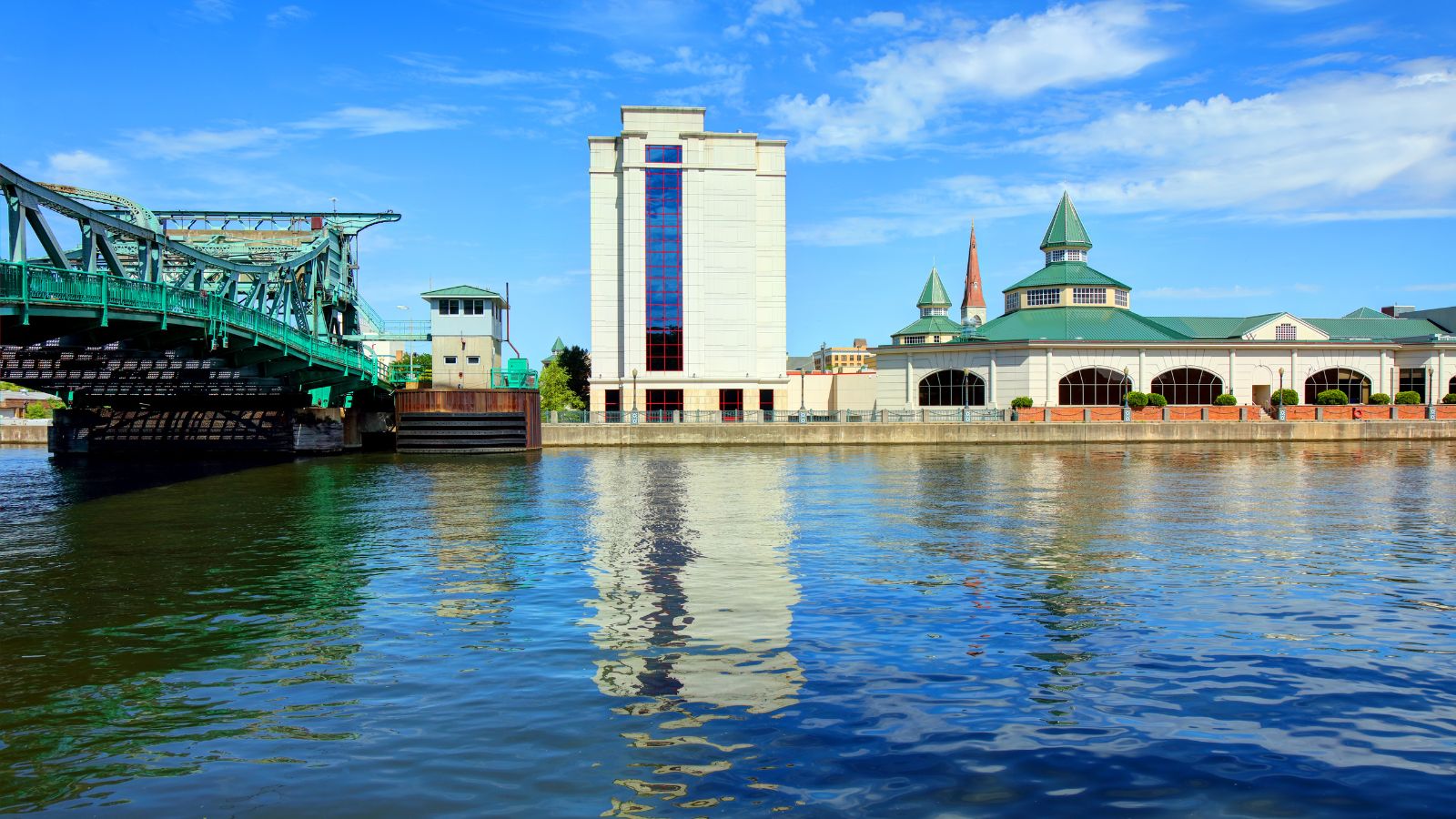Joliet: Your Hometown Haven in the Heartland
Nestled along the tranquil banks of the Des Plaines River, Joliet unfolds a blend of suburban serenity and urban vibrancy. This thriving city, known for its rich history and stunning architecture, offers a beautiful dance between the past and the present. Imagine tranquil nature walks, inspiring cultural explorations, and friendly encounters at local eateries as part of your daily routine. As you wander through the city, you’ll find a community that cherishes its heritage while embracing the promise of tomorrow. Whether you’re a young professional, a growing family, or a retiree, Joliet holds a warm, inviting promise of a place you’d be proud to call home.

The Story of Joliet
Joliet’s story is a rich tapestry woven with tales of growth, innovation, and resilience. The area was first inhabited by Native American tribes and, later, by European settlers who were drawn to the abundant natural resources and the promise of fertile land. The city was initially established as Juliet, named after the daughter of one of the early settlers, James B. Campbell. However, in 1845, it was renamed Joliet in honor of the French Canadian explorer Louis Jolliet, who, alongside Jacques Marquette, mapped the region.
As the years rolled by, Joliet blossomed into an industrial powerhouse. The discovery of limestone in the area fueled the construction and architectural prowess that the city became synonymous with. The city’s quarries provided the much-needed material for building not just locally but in many parts of the country. This era saw the construction of iconic structures such as the Rialto Square Theatre and the Union Station, both of which stand today as grand symbols of Joliet’s architectural heritage.
The construction of the Illinois and Michigan Canal in the 19th century was a game-changer, propelling Joliet into a transportation hub and further augmenting its industrial growth. The canal connected the Great Lakes to the Mississippi River, opening up a world of economic opportunities for the young city. The advent of the railroad era further sealed Joliet’s fate as a nexus of transportation and commerce.
Joliet’s resilience was tested during the Great Depression, but the community pulled together, emerging stronger and more united. Post World War II, the city experienced a boom, diversifying its industries and expanding its cultural and educational landscape.
Today, Joliet wears its history with pride, the bygone eras echoing through its charming streets, historic buildings, and the enduring spirit of its community. The city’s past has shaped its present, fostering a community that values hard work, innovation, and camaraderie. Through each epoch, Joliet has retained its essence, offering a nurturing environment for individuals and families to grow roots, create memories, and build a promising future.
Homes for Sale
Embrace the Vibrance: Lifestyle and Leisure in Joliet
In Joliet, every day holds the promise of a new adventure. The city’s landscape is a delightful blend of natural beauty, cultural richness, and urban sophistication, offering a lifestyle that caters to a variety of interests and passions.
Nature lovers will find tranquility in the numerous parks and green spaces dotting the city. The Rock Run Preserve is a local favorite, offering trails that meander through lush woods and along serene water bodies. It’s a place where the hustle of urban life fades into the background, replaced by the melodious chirping of birds and the rustle of leaves underfoot.
For the culturally inclined, Joliet’s historical theaters and museums are a treasure trove of exploration. The Rialto Square Theatre, often referred to as the “Jewel of Joliet,” hosts a myriad of performances, from Broadway shows to orchestral concerts, ensuring your cultural palate is always intrigued. The Joliet Area Historical Museum, on the other hand, offers a deep dive into the city’s rich heritage, connecting the dots between yesteryears and today.
If you’re a sports enthusiast, you’ll be thrilled by the local baseball games at the Joliet Slammers’ stadium, or perhaps a day at the Chicagoland Speedway revs up your excitement. Golf fanatics have several well-maintained courses to choose from, each offering a unique challenge and picturesque views.
The city also boasts a burgeoning culinary scene. From cozy cafés where baristas know your name to gourmet restaurants offering a taste of the world, the city’s food landscape is as diverse as its residents.
Community events, farmer’s markets, and seasonal festivals knit the residents together, creating a strong sense of belonging and camaraderie. The warmth of the community is the icing on the cake, making the lifestyle in Joliet not just enjoyable but enriching.
In Joliet, the invitation to explore, engage, and enjoy life is open. It’s a city where the community and the environment come together to offer a lifestyle that’s as dynamic and diverse as the people who call it home.
Finding Home: Real Estate in Joliet's Top Neighborhoods
Joliet’s real estate market caters to a diverse range of preferences, offering a blend of historic charm and modern conveniences across its neighborhoods. Here are five communities in Joliet that could be the perfect spot for your next home:
Cathedral Area: This neighborhood exudes historical charm with streets lined with mature trees and homes showcasing unique architectural styles. Many older homes have been tastefully renovated to meld tradition with modern-day living. A close-knit community spirit and a strong sense of neighborhood pride are hallmarks of the Cathedral Area.
Westfield: A relatively newer neighborhood, Westfield boasts modern homes, well-planned streets, and contemporary amenities. It’s family-friendly, with parks, schools, and shopping centers nearby, making it a convenient place for families to settle.
Glenwood Manor: Known for its quiet ambiance, Glenwood Manor offers well-maintained homes nestled in peaceful streets. A mix of single-family homes and townhouses and a suburban feel, with nearby parks and recreational facilities, characterize this area.
Preston Heights: Offering a range of housing styles, Preston Heights is a vibrant community. Amenities like parks, schools, and shopping centers are easily accessible. A good mix of young professionals, families, and retirees contribute to its lively atmosphere.
Timber Estates: Timber Estates is a tranquil neighborhood with spacious homes and large yards. Residents enjoy the calm of suburban living while having access to Joliet’s amenities. The friendly vibe and active community engagement in local events and activities make it a welcoming place.
Each of these neighborhoods offers a unique living experience, ensuring that whether you’re inclined towards historical charm or modern conveniences, there’s a place for you in Joliet.
Educational Landscape: Nurturing Minds in Joliet
Education is a cornerstone of any thriving community, and Joliet is no exception. With a blend of public schools, private institutions, and higher education facilities, the city fosters a nurturing environment for learners of all ages.
Joliet is home to a robust public education system, anchored by Joliet Public Schools District 86, which is the third-largest elementary school district in Illinois, boasting a student enrollment of approximately 9,620 and a staff of 1,669 employees. The district houses various schools, including elementary, junior high, and specialized education centers like Culbertson Elementary, Dirksen Junior High, and Eisenhower Academy, to name a few. Additionally, the Joliet Township High School District 204 provides secondary education to the city’s youth, offering various curricular and extracurricular activities to enrich the learning experience.
When it comes to private education, Joliet offers a range of options. The city hosts 18 private schools, with Cathedral Of St. Raymond School, Joliet Catholic Academy, and St. Jude School being among the top-ranked ones. For instance, Joliet Catholic Academy is a highly rated institution, with a notable 83% of its graduates proceeding to four-year colleges. These private schools provide an alternative educational environment, often with smaller class sizes and specialized programs.
Joliet is also a hub for higher learning. The University of St. Francis is a significant player, offering a variety of undergraduate, graduate, and doctoral programs both on-campus and online. It serves close to 4,000 students nationwide, with diverse programs in arts, sciences, business, education, nursing, and social work. Furthermore, Joliet Junior College, known as the nation’s first public community college, is another excellent institution in the city. It has received a historic investment for community colleges and higher education in the Governor’s FY 2024 budget, indicating a strong commitment to education in the region.
With its blend of public, private, and higher education institutions, Joliet provides a well-rounded educational environment, ensuring that residents have ample opportunities for learning and growth.
Four Seasons of Serenity: Joliet's Gentle Climate
Joliet, Illinois, basks in a climate where each season unfolds its unique charm, painting the city in a myriad of colors and emotions. With an annual high-temperature average of around 60°F and a low-temperature average of 41°F, the area presents a temperate climate that’s both inviting and serene.
Spring is a period of rejuvenation in Joliet. The days gradually warm from the chill of winter, with March seeing average high temperatures in the upper 40s, rising to the 60s and 70s in April and May. It’s a season of blossoming flowers and tender green leaves, where the earth seems to wake from its slumber, although rain showers are a common sight.
The warm embrace of summer follows, offering plenty of sunshine and outdoor enjoyment. Starting in June, the temperatures hover around 80°F on average, peaking in July with averages in the mid-80s. It’s a great time to explore the city’s beautiful parks, attend outdoor events, and soak up the sun despite the occasional thunderstorms that bring refreshing rains.
Autumn graces Joliet with a cool, comfortable atmosphere. September sees high temperatures in the mid-70s, which gently drop to the 60s and then the 50s as October and November roll in. The season is a picturesque blend of colorful foliage and crisp air, ideal for leisurely strolls and exploring the scenic beauty of Joliet without the summer crowds.
Winter, on the other hand, is a time of serene snowscapes and cozy indoor retreats. December introduces the cold with average high temperatures around 35°F, while January, the coldest month, sees highs in the low 30s. The snowfall transforms Joliet into a winter wonderland, providing a tranquil backdrop for the holidays and cozy indoor gatherings.
Each season in Joliet has its unique beauty, offering a range of experiences that cater to different preferences and lifestyles. Whether you’re basking in the summer sun, admiring the autumn foliage, enjoying the spring blooms, or cozying up in the winter snow, Joliet’s climate is a gentle companion to your journey.
Navigating Joliet: Roads, Rails, and Sky
Joliet, Illinois, is conveniently located near major highways, offering easy access to surrounding regions and beyond. Interstate 80 runs through Joliet and Will County, connecting the east and west coasts, making Joliet a part of a significant transportation corridor. Interstate 55 has undergone multiple improvement projects to enhance capacity, access, and safety, including a new diverging diamond interchange with Illinois 59, aimed to alleviate traffic congestion and improve overall road safety in the area.
When it comes to public transportation, Joliet offers a variety of options. The Joliet Transit Center, which opened in December 2021, serves as a multi-modal station housing Pace, Metra, and Amtrak services, making commuting to and from Joliet relatively straightforward. This center is located at Marion & St. Louis Streets in Downtown Joliet, providing a hub for passenger service in the area. Additionally, the Grundy Transit System offers transportation within Grundy County and to areas in Joliet three times each day from Monday to Friday, making public transport accessible to residents and guests.
For air travel, the nearest major airports to Joliet are Chicago Midway International Airport (MDW) and Chicago O’Hare International Airport (ORD), located 39 and about 50 miles away from the city center, respectively. However, Joliet has its regional airport, the Joliet Regional Airport (JOT), situated four nautical miles west of the central business district. This publicly owned airport is managed by the Joliet Park District, offering a convenient option for both business and recreational flyers. It is also a suitable choice for those who prefer a smaller, less crowded airport with reasonable prices on fuel and hangars. Other nearby airports include Lewis University Airport and Clow International Airport, providing additional options for air travel.
Your Next Chapter Awaits in Joliet
As we traverse through the rich history, robust educational framework, serene climate, and accessible transportation networks, it’s clear that Joliet isn’t just a place to live—it’s a place to thrive. Each neighborhood beckons with its unique charm, ready to welcome you into a community that values both its past and its future. Whether you’re drawn to the historic allure of Cathedral Area, the modern conveniences of Westfield, or the tranquility of Timber Estates, Joliet holds a promise of a fulfilling life.
Now that you’ve had a glimpse of what life in Joliet can offer, the next step is finding a place you can call home. That’s where I come in. With a deep understanding of the Joliet real estate market and a genuine passion for helping clients find their perfect home, I am here to guide you through every step of your home-buying journey. When you’re ready to turn the page to your next chapter in Joliet, reach out, and let’s explore the possibilities together. Your dream home in a community that resonates with your lifestyle is waiting for you in Joliet.



